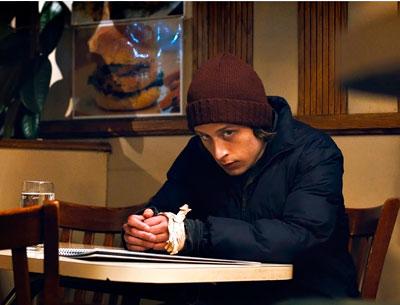Portrait of a Young Man on the Edge

“Gabriel” opens with a shot of a winter landscape just before dawn, its stillness suddenly shattered by the roar of a bus speeding across the screen. A young man in a woolen watch cap and winter coat gazes out the window. He tries harmlessly to engage a little girl who is grinning at him from several rows away. She finally joins him, and they are pretending to be smoking Twizzlers when the girl’s mother rushes up the aisle, snatches her daughter, and drags her back to her seat.
The boy, Gabriel, portrayed by Rory Culkin in a mesmerizing performance, disembarks in a college town and walks to a campus dormitory. He is looking for his former girlfriend, Alice, clutching a battered letter from her.
By the time he leaves the campus, his erratic behavior has frightened two coeds, he has learned that Alice has left for the holidays, and, because he admits that the letter is several years old, we begin to suspect that Gabriel’s relationship to reality is slightly askew.
“Gabriel,” the first feature film by Lou Howe, reveals itself gradually. Gabe, as the boy prefers to be called, has come home from a mental institution, and the reactions of his mother and brother and his own behavior make it clear that he is unbalanced. Gabe is determined to ask Alice to marry him, convinced she will accept, and his family is forced to grapple with the consequences of his obsession.
“I have a close childhood friend who was diagnosed with mental illness during his freshman year in college,” Mr. Howe said. “We’re about the same age, and that was an experience that had and still has a profound effect on me.”
Mr. Howe started trying to understand his friend’s illness by writing first-person journals from a disturbed character’s point of view. “That’s where Gabe came from. I imagined he had been given the assignment by his psychiatrist. Once I started writing, it took on a life of its own and became purely fictional.”
The writer grew up in New York City and attended Harvard. He thought he would be an English major and write fiction, but an introductory video class set him on a different path. “I just fell in love with the process, the equipment, the collaborative nature of it. I took more film classes and fewer English courses and wound up a film major.”
After college, he returned to the city for several years before moving to Los Angeles, where he enrolled in the American Film Institute’s masters program. He started writing the script for “Gabriel” while there, in 2010. The film premiered in April at the Tribeca Film Festival.
Gabe is an edgy, jumpy character, with visible tics that hint at his internal distress. Mr. Culkin’s is a remarkably modulated performance, managing to create tension and keep the viewer on edge without resorting to melodrama or theatrics. With his full lips and sad eyes, he looks at times like a puppy whose masters — his family — are demanding too much from him. He is difficult, frustrating, and, at times, frightening to people he encounters, but Mr. Culkin manages to earn the viewer’s sympathy.
Mr. Howe didn’t write the screenplay with a particular actor in mind, but as soon as his casting director brought up Mr. Culkin’s name, he became excited. “I’ve been a fan of his since he was a little kid working in movies like ‘You Can Count on Me,’ which I loved. Once we met, we really connected on the approach to working together and on the character himself.”
The film moves between New York City and the East End. Gabe’s family lives on the South Fork, and familiar locations range from the Bridgehampton railroad station to the Sag Harbor Variety Store to the South Ferry.
Mr. Howe is no stranger to the region. An aunt and uncle have lived full time in East Hampton for many years, and his wife summered here when growing up. “We were married in East Hampton, so for eight years I’ve been spending a lot of time with my in-laws there. It’s a place that’s very close to my heart, so it made sense to set some of the movie there.”
Mr. Howe got his start on the film with grants from several independent film organizations, including the Sundance Institute and Cinereach in Manhattan. “Then we raised the money privately, starting with family and friends, and it grew from there. It was sort of like targeted crowdfunding.”
“Gabriel” is exactly the film Mr. Howe wanted to make. His brother and an old friend are the two main producers. “We were able to make the movie the way we wanted to, and we were lucky we found investors who agreed with us.”
Mr. Howe intends to keep working as an independent, “but gradually scaling it up. The way we made this is pretty ideal, but as the stories get bigger and the budgets get bigger, it gets harder and harder to do it that way.” He wouldn’t be opposed to a studio project, and he finds current television interesting. So the low-budget, independent route isn’t the only one he would be willing to take — “but it’s my preferred way right now.”
In addition to being part of the festival’s World Cinema series, “Gabriel” is also included in the Views From Long Island category, five films of which one will win a grant of $6,000 from the Suffolk County Film Commission. “Gabriel” will screen tomorrow at 6:30 p.m. at Sag Harbor Cinema and Sunday evening at 8:30 at East Hampton UA 5.
